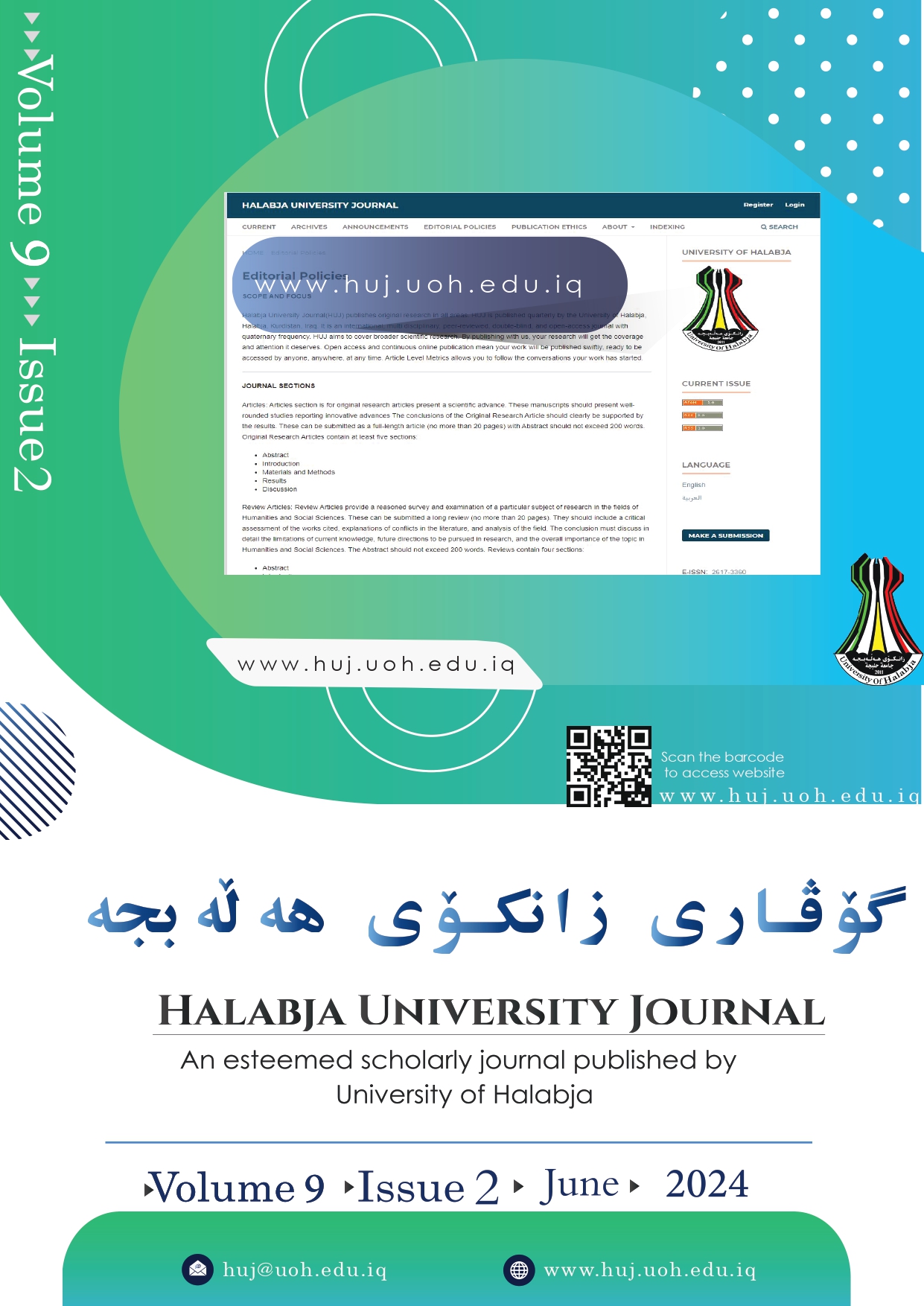Reading of Latif Halmat’s poem(Gorany) According to the Method of Structural Criticism
.
DOI:
https://doi.org/10.32410/huj-10534Keywords:
Method, Construction Method, Criticism, Similarity, Antipathy, Latif HalmatAbstract
Structuralism is a conceptual and methodological approach to describing and analyzing literature texts. This approach sees the text as separate entity that should be treated independently. In literature, (the author, the text, the reader) focuses on the text. Ferdinand de Saussure, a Swiss linguist, semiotician, and philosopher propounded the structuralism theory also known as structuralism. This approach focuses on the literary text, the text is the center for the analysis. It ignores the author's life and environment, i.e. in analyzing the structures of literary text, Structuralism is general theory of culture and methodology that implies that elements of human culture must be understood by the way of their relationship to a broader system. This makes it different from approaches like psychoanalysis and historical-biographical approach that focuses on the psychology the biography of the writer, the environment, and the social environment, structuralism only cares about the text and uses textual elements to understand meaning. From the perspective of Structuralism this paper tries to analyze Latif Halmat’e poem (Gorani). Dualism is a concept of structuralism, and this paper concludes that Latif Halmats poem is based on dualism. The aim of this research is to further clarify the way in which the Structuralism method is applied to poetry in order to further clarify the authority of this method over analyzing poetic texts.
References
كتێب:
- پیتهر هالبێرگ و دانهرانی تر(2010)، تیۆری ئهدهبی و شێوازناسی، و/ ئهنوهر قادر محمد، مهڵبهندی كوردۆلۆجی، سلێمانی،.
- تێرى ئیگڵتن(2016)، تیۆرى ئەدەبى, و. عەتا قەرەداغى, چاپخانەى تاران.
- دیوانی لهتیف ههڵمهت، پری ئهو كچه ڕەشماڵی گهرمیان و كوێستانمه(1977)، چاپخانهی تاران، چاپی یهكهم، 2014.
- حسین، علی تاهیر(2008)، رهخنهی بونیادگهریی له تیۆرهوه بۆ پراكتیزهكردن، دهزگای چاپ و پهخشی سهردهم، چاپی یهكهم، سلێمانی.
- مهنتك، حهمه( 2018)، میتۆدهكانی ڕەخنهی ئهدهبی، نوسینگهی تهفسیر بۆ چاپ و بڵاوكردنهوه، ههولێر.
- ئهسوهد، نهوزاد ئهحمد(2015) ، فهرههنگی زاراوهكانی ئهدهب و زانسته مرۆڤایهتییهكان، چاپی یهكهم ، چاپخانهی تاران.
- حسێن، هیمداد(2010) ، دهروازهیهك بۆ ڕەخنهی ئهدهبی نوێی كوردی، چاپخانهی باز، چاپی دووهم، ههولێر.
- بێرتێنز، هانز(٢٠١٥)، بنەماکانى تیۆرى ئەدەبى،و: عبدالخالق یعقوبى، چاپخانەى سەردەم، سلێمانى.
گۆڤار:
- عومهر، نهوزاد ئهنوهر( 2015)، میتۆدی بونیادگهری و تێڕوانینێكی پراگماتیكی(مۆبایله سیعر) بهنمونه، ژماره 37 تشرینی یهكهم، گۆڤاری زانكۆی كۆیه.
- مستهفا، ئهحمهد، و صافیه احمد(2016)، شیكردنهوهی دژیهك له شیعرهكانی(نالی)دا، ژماره 38 تشرینی یهكهم، گۆڤاری زانكۆی كۆیه.
- حسێن، ناهید( 2021)، نیشتمانی زەوتکراو لە شیعرى (کۆترى خاسە و ڕەحیماوا)ى (کەژاڵ ئەحمەد) دا توێژینەوەیەکی بونیادگەرانەیە،ژمارە(4)، لاپەڕە(383- 401) گۆڤاری زانكۆی تكریت.
كتێب به زمانی عهرهبی:
-باعیسی، عبدالقادر علی( 2004)، فی مناهج القراءة النقدیة الحدیثة، مركز عبادی للدراسات والنشر، صنعاء.
- فضل، صلاح(1998)، نظريه البنائیه فی النقد الادبی، دار الشروق، القاهرة.
كتێب به فارسی:
- ریما مکاریک(۱۳۸۴)، دانشنامه نظریههای ادبی معاصر، ویراستار و ترجمه مهران مهاجر و محمد نبوی، انتشارات آگه، تهران.
- پیشگاهی فرد و قره بیگی، زهرا، مصیب(1392)، جغرافیای پساساختارگرا. نشر زیتون سبز. تهران.
- سیما داد(1373). فرهنگ اصطلاحات ادبی. انتشارات مروارید. تهران.
- رنه ولک – اوستن وارن(1382). نظریه ادبیات. ترجمه ضیاء موحد- پرویز مهاجر. چاپ سوم. انتشارات نیلوفر.. تهران.
Downloads
Published
Issue
Section
License
Copyright (c) 2024 Rebaz Mohammed Amin, Hawkar Qadir Rasul, Kwestan Ali Hamakarim

This work is licensed under a Creative Commons Attribution-NonCommercial-NoDerivatives 4.0 International License.
Authors who publish with this journal agree to the following terms:
- Authors retain copyright and grant the journal right of first publication with the work simultaneously licensed under a Creative Commons Attribution License [CC BY-NC-ND 4.0] that allows others to share the work with an acknowledgment of the work's authorship and initial publication in this journal.
- Authors are able to enter into separate, additional contractual arrangements for the non-exclusive distribution of the journal's published version of the work (e.g., post it to an institutional repository or publish it in a book), with an acknowledgment of its initial publication in this journal.
- Authors are permitted and encouraged to post their work online (e.g., in institutional repositories or on their website) prior to and during the submission process, as it can lead to productive exchanges, as well as earlier and greater citation of published work (See The Effect of Open Access).






